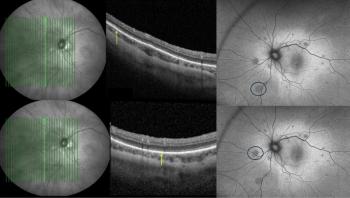
The more you know: Expanding knowledge about ROP development, progression
Findings may help pediatricians and ophthalmologists to determine the appropriate timing of examinations and treatment.
Spanish researchers report that the risk factors for development of retinopathy of prematurity (ROP) and the disease’s progression differ.1 Their findings may help “facilitate screening, early diagnosis, and ROP treatment while reducing unneeded examinations,” they said.
Nieves de las Rivas Ramírez, MD, lead author from the Department of Ophthalmology, Hospital de la Serranía, Málaga, Spain, and colleagues explained that ROP is thought to be a two-stage disorder that begins with the arrested development of the retinal vessels in preterm babies when exposed to high oxygen levels at birth. The resultant hypoxia causes up-regulation of angiogenic growth factors and the neovascularization risk.
In their retrospective study, the investigators set out to determine the potential risk factors of ROP in this growing patient population and establish their influence in ROP development and progression to learn the reason why ROP progresses in some patients and improves in others.
They retrospectively collected data from 2015 to 2018 from babies born prematurely who weighed 1,500 grams or less and/or were a gestational age of less than 32 weeks, and from babies with a birthweight between 1,501 and 2,000 grams and/or had a gestational age of 32 weeks or older who received oxygen for longer than 72 hours or had an unstable clinical course and were screened for ROP in a regional university hospital in Málaga.
The investigators reported that a total of 202 infants (44.7%) developed ROP and 66 showed disease progression (32.7% of ROP infants).
The different risk factors identified had different roles.
The univariate analysis identified a number of risk factors associated with ROP. Multivariate analysis showed that the gestational age, oxygen therapy, and weight at 28 days of life, the length of mechanical ventilation, non-invasive ventilation, surfactant administration, and late-onset sepsis were independently associated with ROP development.
In contrast, the duration of the oxygen therapy, late-onset sepsis, and weight at 28 days were associated with ROP progression.
“Our study suggests that, on the one hand, gestational age is the first risk factor to determine ROP development risk; on the other hand, the duration of supplemental oxygen therapy is the first predictor of ROP worsening. These findings may help pediatricians and ophthalmologists to evaluate the risk of ROP development and progression and determine the appropriate timing of examinations and treatment,” the authors commented.
Reference
de las Rivas Ramírez N, Luque Aranda G, Rius Díaz F,et al.Risk factors associated with retinopathy of prematurity development and progression.Sci Rep. 2022;12:21977; https://doi.org/10.1038/s41598-022-26229-4
Newsletter
Get the essential updates shaping the future of pharma manufacturing and compliance—subscribe today to Pharmaceutical Technology and never miss a breakthrough.













































